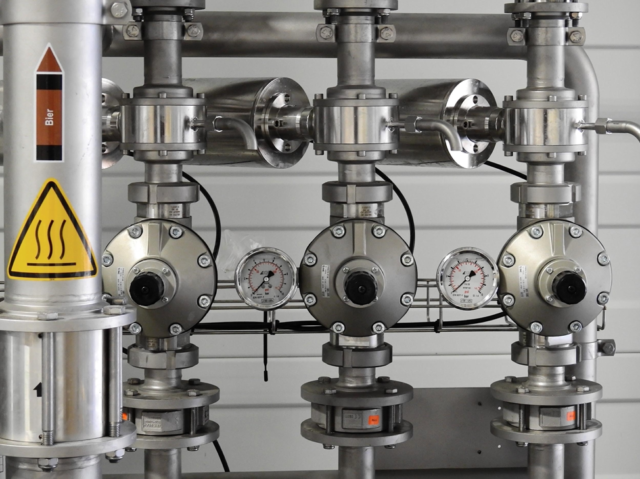Valves play a crucial role in the smooth operation of any piping system, whether it’s used to transport compressed air or a liquid or gaseous substance. They are typically implemented in order to manage and restrict certain forms of media.
A butterfly valve excels in moderate-to-high temperature and pressure applications, while a gate valve is used in a wide variety of media. It includes those with granular materials and high viscosity like steam, oil, and other liquids. Its small footprint and low cost per unit mean it can be used in more places than its larger counterparts.
The two most common types of valves used in various contexts are butterfly valves and gate valves. This article explains the similarities and differences in terms of butterfly valve vs gate valve, including their structure, mechanisms, and uses.
Humphrey is a leading producer of pneumatic products and directly operated valve technology including quick exhaust valves, air valves, and pneumatic cylinders. you may find Humphrey products here.
Table of Contents
A Comparison of Gate and Butterfly Valves
You’ll likely be able to tell the two apart after reading the definitions of gate and butterfly valves. Most notably, their construction, operation, and suggested uses.
Let’s take these differences one at a time and delve into a deeper discussion.
1. Architectural Drafting
Wedge gate valves use a wedge to allow or prevent fluid flow, while butterfly valves use a rotating disc. In addition, their bodies and discs are designed differently from one another.
A gate valve’s body-bonnet design can feature either a bolted or a screwed bonnet, a bonnet with a pressure seal, or a welded bonnet. In addition to the wedge, disc, conduit, and parallel slide designs, the butterfly valve also comes in wafers, lug, flanged, and butt-welded varieties.
Moreover, its disc offset design features a zero offset (concentric), double offset (eccentric), and triple offset (eccentric) variant.
2. Capabilities & Applications
In systems where tight sealing is necessary but frequent switching is not, such as in a medical molding factory, the gate valves are commonly used because of their exceptional sealing performance. Its purpose is to stop the flow of the circulating medium but not to control the flow rate. It is not ideal for pipelines that need instant shut-offs, like those that use a butterfly valve, because of how slowly it opens and closes.
The butterfly valve operation principle is widely used for limiting and regulating flow. Its effortless opening and closing make it a good choice for fast-acting systems. Because of its compact size and lightweight, a butterfly valve is an excellent choice for applications with restricted mounting options.
As a result of these benefits, butterfly valves are quickly replacing ball valves as the industry standard.
3. Components of a Working Mechanism
First, we’ll compare the butterfly valve to the more traditional gate valve, which operates with a swinging door. In order to open or close the gate, a machine operator, typically a threaded screw, is used to lower or raise the disc of solid material that attaches to the stem. It is controlled by turning a handwheel, or actuator, which is its most recognizable feature.
As a result of this power, the system thread becomes a gate in its open state and a thread in its closed state. This causes the gate to rise and fall. When the valve is in its open position, fluid flow is minimally impeded because the gate is completely out of the medium’s path and the door can fully open and close.
A butterfly valve’s operation is similar to that of a ball valve, another type of quick-closing valve. They are less expensive, lighter, and need less support than alternative valves.
A butterfly valve consists of a disc in the center of the pipe and an actuator and rod on either side of the disc, respectively. As the actuator is rotated, the disc is oriented perpendicular or parallel to the medium flow.
Unlike a ball valve, a butterfly valve’s disc participates in the flow and reduces pressure even when the valve is fully open. Quarterly rotation allows for complete opening and closing.
A metal disc shaped like a butterfly is attached to the rod. Because the disc only turns 90 degrees to block or release flow through the pipeline, its useful life is shorter than that of gate valves.
4. Price
The price of butterfly valves is typically lower than that of gate valves for applications requiring the same specifications, diameter, and material. While gate valves may be more affordable than butterfly valves of similar size, the price of a larger caliber quickly outpaces the initial savings.
Since butterfly valves continue to be less expensive, even larger sizes, they are widely used across many industries such as by auto accessories manufacturer firms.
Conclusion
Both gate and butterfly valves have advantages and disadvantages, but these will vary depending on the specifics of the installation. In most cases, gate valves are the best choice when the unrestricted flow is desired, and only minimal maintenance is required, such as when sealing is required.
In contrast, large butterfly valves are a great choice when a compact throttling valve is required for extremely large systems.








